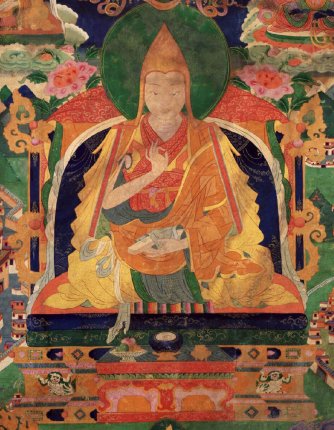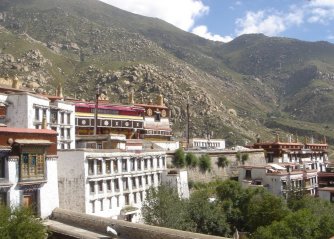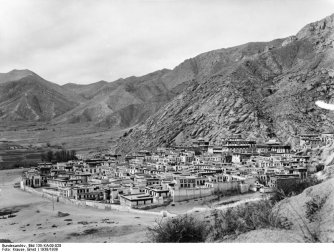| Library / Biographies |
The Second Dalai Lama, Gedun Gyatso Biography

The Second Dalai LamaGedun Gyatso Palzangpo, "Sublimely Glorious Ocean of Spiritual Aspirants" (1475–1542), was considered posthumously to be the second Dalai Lama.
He was born near Shigatse at Tanak as Sangye Phel, in the Tsang region of Central Tibet. His father, Kunga Gyaltsen (1432–1481) was a disciple of the Sakya patriarch Namkha Neljor (1388-1469), founder of the Sakya monastery Tanak. His mother was Machik Kunga Pemo. They were a farming family.
Legend has it that soon after he learned to speak, he told his parents his name was Pema Dorje, the birth name of Gendun Drup (1391–1474) and that his father was Lobsang Drakpa, which was Tsongkapa's ordination name.
When he was four, he reportedly told his parents he wished to live in the Tashilhunpo monastery (next to Shigatse and founded in 1447 by Gendun Drup) to be with his monks.
He was proclaimed the reincarnation of Gendun Drup as a young boy – according to some sources at the age of four years, and to others at eight. When monks from Tashilhunpo came to his home, it is said that the child was delighted at their appearance and greeted each of them by name.
He received his novice vows from Panchen Lungrig Gyatso in 1486, at the age of ten, and his vows of an ordained monk from Ghoje Choekyi Gyaltsen who gave him his ordination name of Gedun Gyatso.
At the age of eleven, he was enthroned as the reincarnation of Gendun Drup at Tashilhunpo monastery. He received his novice and then full ordination vows.
He remained at Tashilhunpo until he was 16 or 17 but, then, due to "some controversies or jealousy" he had to leave the monastery and went to Lhasa to study at Drepung Monastery, where he studied with Jamyang Lekpai Chojor. There he took full ordination and completed his studies.
Gendun Gyatso spent next twenty years in practice, pilgrimage, and teaching. He received teachings from yogi Khedrub Norsang Gyatso1, with whom he spent many months meditating. Gendun Gyatso’s biographies state that he attained enlightenment under the tutelage of this master.
He was a renowned scholar and composer of mystical poetry, who traveled widely to extend Gelugpa influence, and became abbot of the largest Gelugpa monastery, Drepung, which from this time on was closely associated with the reincarnation line which eventually would be known as that of the Dalai Lamas. According to Sumpa Khenpo, the great Gelug scholar, he also studied some Nyingmapa tantric doctrines.

Drepung MonasteryIn 1517 he became abbot of Drepung monastery and he revived the 'Great Prayer Festival' or Monlam Chenmo in 1518, presiding over the celebration with monks from the three large Gelug monasteries of Sera, Drepung and Gaden2.
It is said that Palden Lhamo, the female guardian spirit of the sacred lake, Lhamo La-tso, promised the First Dalai Lama in one of his visions "that she would protect the reincarnation lineage of the Dalai Lamas."
Since the time of Gendun Gyatso, who formalized the system, monks have gone to the lake to seek guidance on choosing the next reincarnation through visions while meditating there. Gendun Gyatso is said to have been the first to discover the sacredness of Lake Lhamoi Latso.
In 1509 he went to southern Tibet and founded the monastery of Chokorgyel Monastery (Chokhor-gyal) close to lake Lhamo La-tso, about 115 km northeast of Tsetang and at an altitude of 4,500 m, while the lake itself is at an altitude of about 5,000 m.
Gedun Gyatso became abbot of Tashilhunpo in 1512 at the age of thirty-six.

Sera MonasteryHe became abbot of Sera monastery in 1525 or 1528; Sera had been founded in 1419, by Jamchen Chojey (Sakya Yeshe), a disciple of Tsongkhapa.
Around 1530 Gendun Gyatso built the Ganden Podrang. It was built on land donated by the Pakmodru3 leader. This came to be the residence of the Dalai Lamas until the Potala was built in the seventeenth century and gave its name to the government of the Dalai Lamas after the time of the Fifth Dalai Lama.
In 1541 he founded Ngari Dratsang monastery in Nedong, in response to the growing support for Geluk teachings.
Gedun Gyatso died in deep meditation at the age of 67 in 1542.
Disciples
• Paṇchen Sonam Drakpa
• The Third Paṇchen Lama, Wensapa Lobzang Dondrub
• The Twenty-First Ganden Tripa, Gelek Pelzang
• Shakya Gyeltsen
• Miyowa Zhonnu Lodro
• Jedrung Sherab Wangpo
• The Third Lelung Jedrung
Writings
• Song of a Young Reincarnation
• A Dance to Delight the World
• Song of the Yarlung Valley
• Song of the Travelling Bee
• From a Vision of Lama Tsongkhapa
• Meditations to Prepare the Mind for Death
• Song of the Enlightenment Path
• Song of the Tantric Path
• A Prayer of Pure Aspirations
• Spiritual Advice to a Hermit
• In Search of Middle View
• Song of Tantric Experience
• A Prayer to Spiritual Master
• Song to the Three Jewels of Refuge
Sources
• https://en.wikipedia.org/wiki/2nd_Dalai_Lama
• https://de.wikipedia.org/wiki/Khedrub_Norsang_Gyatsho
• https://treasuryoflives.org/biographies/view/Gendun-Gyatso/TBRC_P84
Footnotes
1. Khedrub Norsang Gyatsho (1423-1513) was an important Tibetan scholar and clergyman of Tibetan Buddhism in the 15th century. He was a student of the 1st Dalai Lama and the main teacher of the 2nd Dalai Lama. He was one of the Gelug school, but represented a syncretic approach to the Mahamudra teachings and practices between the Gelug and Kagyu. He is revered as a great meditator and teacher in the Tibetan tradition and is one of the masters of many lineages of practice, including Kalachakra .
2. Ganden was the original monastery of the Gelug order, founded by Je Tsongkhapa in 1409
3. The Phagmodrupa dynasty or Pagmodru was a dynastic regime that held sway over Tibet or parts thereof from 1354 to the early 17th century. It was established by Tai Situ Changchub Gyaltsen of the Lang family at the end of the Yuan dynasty. The dynasty had a lasting importance on the history of Tibet; it created an autonomous kingdom after Mongol rule, revitalized the national culture, and brought about a new legislation that survived until the 1950s.





